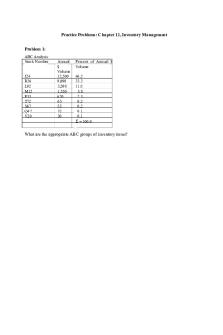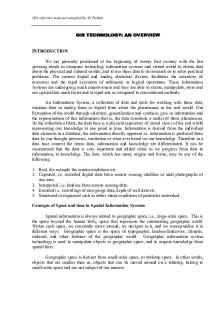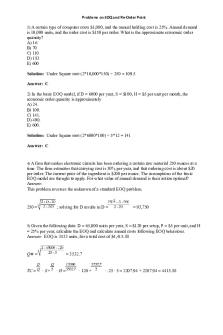Teacher Additional Notes EOQ EBQ PDF

| Title | Teacher Additional Notes EOQ EBQ |
|---|---|
| Course | Management |
| Institution | Griffith College |
| Pages | 6 |
| File Size | 214.5 KB |
| File Type | |
| Total Downloads | 65 |
| Total Views | 161 |
Summary
Class notes on EOQ & EBQ. Includes calculations, formulas and explanations....
Description
Economic Order Quantity (EOQ) The EOQ is the reorder quantity which minimises the total costs associated with holding and ordering stock (i.e. (holding costs + ordering costs) are at a minimum at the EOQ).
Where: D = Demand per annum Co = Cost of placing one order Ch = Cost of holding one unit for one year Q = Reorder quantity (EOQ) EOQ assumptions There are a number of important assumptions and formulae related to the EOQ that you should note.
• •
Average inventory held is equal to half of the EOQ = EOQ/2. The number of orders in a year = Expected annual demand/EOQ.
•
Total annual holding cost = Average inventory (EOQ/2) x holding cost per unit of inventory.
•
Total annual ordering cost = Number of orders x cost of placing an order.
Example The economic order quantity (EOQ) A company uses components at the rate of 500 units per month, which are bought in at a cost of $1.20 each from the supplier. It costs $20 each time to place an order, regardless of the quantity ordered. The total holding cost is 20% per annum of the value of stock held. How many components should the company order? What is the total annual cost?
Solution
EOQ =
√ = 1,000 components
TAC =
The EOQ with discounts Quantity discounts It is often possible to negotiate a quantity discount on the purchase price if bulk orders are placed. •
If a quantity discount is accepted this will have the following effects: – The annual purchase price will decrease. – The annual holding cost will increase. – The annual ordering cost will decrease – To establish whether the discount should be accepted or not, the following calculations should be carried out. – Calculate TAC with the discount. – Compare this with the annual costs without the discount (at the EOQ point).
EOQ when quantity discounts are available The steps involved in calculating the EOQ when quantity discounts are available are as follows: 1. 2.
Calculate the EOQ, ignoring discounts. If the EOQ is smaller than the minimum purchase quantity to obtain a bulk discount, calculate the total for the EOQ of the annual stockholding costs, stock ordering costs and stock purchase costs. 3. Recalculate the annual stockholding costs, stock ordering costs and stock purchase costs for a purchase order size that is only just large enough to qualify for the bulk discount. 4. Compare the total costs when the order quantity is the EOQ with the total costs when the order quantity is just large enough to obtain the discount. Select the minimum cost alternative.
5.
If there is a further discount available for an even larger order size, repeat the same calculations for the higher discount level.
Example The EOQ with discounts A company uses components at the rate of 500 units per month, which are bought in at a cost of $1.20 each from the supplier. It costs $20 each time to place an order, regardless of the quantity ordered. The supplier offers a 5% discount on the purchase price for order quantities of 2,000 items or more. The current EOQ is 1,000 units. The total holding cost is 20% per annum of the value of stock held. Required: Should the discount be accepted? Solution Order Quantity
1,000
2,000
$
$
Order Cost (6,000/1,000 x $20) =
120
(6,000/2,000 x $20) =
60
Holding Cost (20% x $1.20 x 1,000/2) =
120
($0.24 x 0.95 x 2000/2) =
228
Purchase Cost (6,000 x $1.20) =
7,200 (6,000 x $1.20 x 0.95) =
6,840
Total Annual Costs
7,440
7,128
The discount should be accepted because it saves the company $312 ($7,440-$7,128).
Gradual replenishment of inventory The situations we have looked at so far have involved inventory levels being replenished immediately when organisations buy inventory from suppliers. Similar problems are faced by organisations who replenish inventory levels gradually by manufacturing their own products internally.
•
The decisions faced by organisations that manufacture and store their own products involve deciding whether to produce large batches at long intervals OR produce small batches at short intervals.
•
An amended EOQ model is used to help organisations to decide which course of action to take.
•
The amended EOQ model is known as the EBQ (economic batch quantity) model.
•
As the items are being produced, there is a machine setup cost. This replaces the ordering cost of the EOQ.
•
In the EOQ, inventory is replenished instantaneously whereas here, it is replenished over a period of time.
•
Depending on the demand rate, part of the batch will be sold or used while the remainder is still being produced.
•
For the same size of batch (Q), the average inventory held in the EOQ model (Q/2) is greater than the average in this situation (see diagram below).
•
The maximum inventory level will never be as great as the batch size, because some of the batch will be used up while the remainder is being produced.
The EBQ The EBQ model is primarily concerned with determining the number of items that should be produced in a batch (compared to the size of an order with the EOQ). The formula for the EBQ is as follows:
Economic Batch Quantity = √2CoD / Ch(1 – D/R) Where: Q = Batch size D = Demand per annum Ch = Cost of holding one unit for one year Co = Cost of setting up a batch ready to be produced R = Annual replenishment rate Example Gradual replenishment of inventory
The following is relevant for Item X:
• • • •
Production is at a rate of 500 units per week. Demand is 10,000 units per annum; evenly spread over 50 working weeks. Setup cost is $2,700 per batch. Storage cost is $2.50 per unit for a year.
Required: Calculate the economic batch quantity (EBQ) for Item X. Solution Annual production rate, R = 500 x 50 = 25,000 units Annual demand rate = 10,000 units Cost per setup, Co = $2,700 Cost of holding one item in inventory per year, Ch = $2.50 EBQ =...
Similar Free PDFs

Teacher Additional Notes EOQ EBQ
- 6 Pages

Modul AA025 - ADDITIONAL NOTES
- 88 Pages

Contracts - additional notes
- 17 Pages

EOQ Practice Problems
- 1 Pages

EOQ Problems - Mandatory
- 7 Pages

Modelo EOQ Básico Inventado
- 1 Pages

Additional Note GIS - gis notes
- 59 Pages

Modelo EOQ - wwwwwww
- 17 Pages

Contract law (law teacher notes)
- 27 Pages

Unit 5 Notes - Xyz teacher
- 14 Pages

Teacher Interview
- 3 Pages

Problems on EOQ with answers
- 5 Pages
Popular Institutions
- Tinajero National High School - Annex
- Politeknik Caltex Riau
- Yokohama City University
- SGT University
- University of Al-Qadisiyah
- Divine Word College of Vigan
- Techniek College Rotterdam
- Universidade de Santiago
- Universiti Teknologi MARA Cawangan Johor Kampus Pasir Gudang
- Poltekkes Kemenkes Yogyakarta
- Baguio City National High School
- Colegio san marcos
- preparatoria uno
- Centro de Bachillerato Tecnológico Industrial y de Servicios No. 107
- Dalian Maritime University
- Quang Trung Secondary School
- Colegio Tecnológico en Informática
- Corporación Regional de Educación Superior
- Grupo CEDVA
- Dar Al Uloom University
- Centro de Estudios Preuniversitarios de la Universidad Nacional de Ingeniería
- 上智大学
- Aakash International School, Nuna Majara
- San Felipe Neri Catholic School
- Kang Chiao International School - New Taipei City
- Misamis Occidental National High School
- Institución Educativa Escuela Normal Juan Ladrilleros
- Kolehiyo ng Pantukan
- Batanes State College
- Instituto Continental
- Sekolah Menengah Kejuruan Kesehatan Kaltara (Tarakan)
- Colegio de La Inmaculada Concepcion - Cebu



